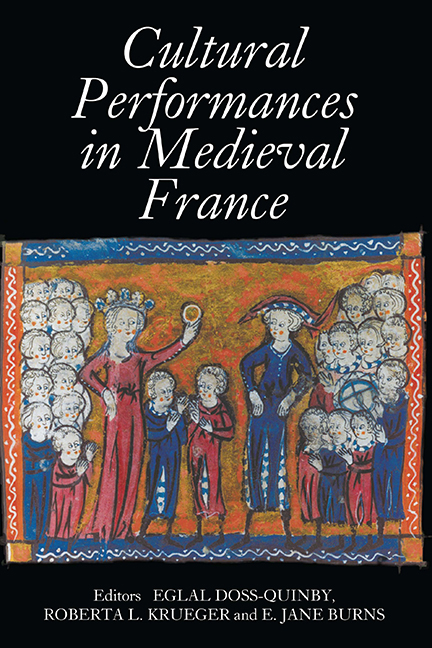Book contents
- Frontmatter
- Contents
- List of Illustrations
- Contributors
- Introduction
- Nancy Freeman Regalado, Curriculum Vitae
- PART I POETIC AND MUSICAL PERFORMANCES
- PART II PERFORMING SEXUAL AND SOCIAL IDENTITIES
- PART III DEVOTIONAL PRACTICE AND TEXTUAL PERFORMANCE
- PART IV PERSUASIVE PERFORMANCES
- PART V RE–ENACTMENTS AND LEGACIES
- Variegated Performance of Aucassin et Nicolette
- Late Medieval Representations of Storytelling and Story-Performance
- Paratextual Performances in the Early Parisian Book Trade: Antoine Vérard's Edition of Boccaccio's Nobles et cleres dames (1493)
- “Resuscitating” Medieval Literature in New York and Paris: La femme que Nostre-Dame garda d'estre arse at Yvette Guilbert's School of Theatre, 1919–24
- The Pitfalls and Promise of Classroom Performance
- ” Dunc chante haut et cler » : remarques sur l'interprétation de la musique médiévale
- Tabula Gratulatoria
- Tabula Gratulatoria
Paratextual Performances in the Early Parisian Book Trade: Antoine Vérard's Edition of Boccaccio's Nobles et cleres dames (1493)
from PART V - RE–ENACTMENTS AND LEGACIES
Published online by Cambridge University Press: 24 October 2017
- Frontmatter
- Contents
- List of Illustrations
- Contributors
- Introduction
- Nancy Freeman Regalado, Curriculum Vitae
- PART I POETIC AND MUSICAL PERFORMANCES
- PART II PERFORMING SEXUAL AND SOCIAL IDENTITIES
- PART III DEVOTIONAL PRACTICE AND TEXTUAL PERFORMANCE
- PART IV PERSUASIVE PERFORMANCES
- PART V RE–ENACTMENTS AND LEGACIES
- Variegated Performance of Aucassin et Nicolette
- Late Medieval Representations of Storytelling and Story-Performance
- Paratextual Performances in the Early Parisian Book Trade: Antoine Vérard's Edition of Boccaccio's Nobles et cleres dames (1493)
- “Resuscitating” Medieval Literature in New York and Paris: La femme que Nostre-Dame garda d'estre arse at Yvette Guilbert's School of Theatre, 1919–24
- The Pitfalls and Promise of Classroom Performance
- ” Dunc chante haut et cler » : remarques sur l'interprétation de la musique médiévale
- Tabula Gratulatoria
- Tabula Gratulatoria
Summary
When Pierre Gringore had the first-known ordonnance protecting an author writing in French printed in the colophon of his Folles entreprises in December 1505, a new breed of writer was born. Or rather, a new ground-breaking use was made of the paratext of printed books: the author was now featured in defiant fashion. Writers such as Gringore did not suddenly develop a consciousness about the place of prominence they deserved on the literary stage, however. New bookpublishing strategies resulting from the advent of print, in particular innovative paratextual “performances” orchestrated by a bold new class of printers and publishers, played a critical role in challenging authors to assume their responsibilities as literary creators in a more dramatic and dynamic manner. Testing and forcing the undefined limits of their new functions, bookmakers often triggered an equally provocative response on the part of authors, such as Gringore. His experience as an actor, dramatist, and director in Parisian theatrical events likely contributed to his heightened sense of visual and verbal performance in both his literary texts and the paratextual apparatus of the books that contained them.
One of the most famous Parisian publishers of the time, the kind of entrepreneur whose actions Gringore targeted with the advertisement of his authorprivilege ordonnance in December 1505, was Antoine Vérard (fl. 1485–1512). Because he successfully exploited the writings of past and present authors for his own ends, this publisher's output offers fascinating insight into underlying bookmaking tensions during the decade preceding Gringore's advertisement of his author privilege. While the simultaneous reproduction of manuscripts and printed books continued during the late fifteenth and early sixteenth centuries, Vérard's contribution to the Parisian book market stands out for his publication of hybrid books. These luxury copies of his imprints were reproduced on vellum instead of paper and often illustrated with miniatures painted by hand in place of the original woodcuts. With this parallel system of book production, Vérard attracted a broad clientele of unknown readers through his paper copies of the work and inspired particular patrons to order and purchase his more expensive hybrid versions of them. Thus, the relationship between Vérard and his projected audience was of capital importance.
- Type
- Chapter
- Information
- Cultural Performances in Medieval FranceEssays in Honor of Nancy Freeman Regalado, pp. 255 - 264Publisher: Boydell & BrewerPrint publication year: 2007



